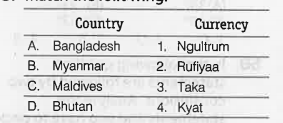(1) Write the state of hybridisation of C - atoms menthoned in each of the following compounds:
(a) C - 4 of pent - 1 en - 4 - yne
(b) C - 1 of Propanoic acid
(d) C - 3 of Pentan - 3 - one and
( e ) C - 3 of 3,3 diethylpentane
(2) Which atoms of each of the following molecules / ions always remain in the same plane?
(a) CH3CH=CHCH3
(b) C6H5C≡C−CN
(c) C6H5CH3
(d) CH2=C=CH2
(e) CH3COCH3
(f) CH−(3)CONH2
(g) CI3C−CH−ΘCH2
(h) (CD3)3⊕C
(i) 
(j) 
(k) ΘCH2COCH2CH3
(i) 
(m) (CH3)2⊕CH−NH2
(1) If four valencies of carbon atom are satisfied by four single bonds, then is sp3 - hybrdised. If four valenices are satisfied by one double bond and two single bonds, then it is sp2-hybridised. If four valencies are satisfied by one triple bond and one single bond or by two double, bonds then it is sp - hybridised.

(2) An sp2 - hybridised C - atom and the directly attached to it remain in the same plane. Again, an sp - hybridised C - atom along with the atoms with which it is directly attached remain in a straight line. Therefore, in a molecule containing both sp2 - and sp - hybridised carbons, all the atoms remain in the same plane (except 1, 2 - dienes). A negataively charged C - atom (or a heteroatom containing lone pairs of electrons such as N, O etc.) adacent to a double bond is sp2 - hybridised and the atoms attached to that carbon or heteroatom remain in the plane of the system containing the double bond. Therefore, the atoms in the given molecules/ions which remain in the same plane are as follows:

Topper's Solved these Questions
- ORGANIC CHEMISTRY : BASIC PRINCIPLES AND TECHNIQUES BOOK - CHHAYA PUBLICATIONCHAPTER - ORGANIC CHEMISTRY : BASIC PRINCIPLES AND TECHNIQUES EXERCISE - SOLVED WBCHSE SCANNER
38 Videos
- ORGANIC CHEMISTRY : BASIC PRINCIPLES AND TECHNIQUES BOOK - CHHAYA PUBLICATIONCHAPTER - ORGANIC CHEMISTRY : BASIC PRINCIPLES AND TECHNIQUES EXERCISE - SLOVED NCERT EXERCISE
38 Videos
- ORGANIC CHEMISTRY : BASIC PRINCIPLES AND TECHNIQUES BOOK - CHHAYA PUBLICATIONCHAPTER - ORGANIC CHEMISTRY : BASIC PRINCIPLES AND TECHNIQUES EXERCISE - WARM UP EXERICSE
132 Videos
- MODEL QUESTIONS PAPER BOOK - CHHAYA PUBLICATIONCHAPTER - MODEL QUESTIONS PAPER EXERCISE - SET III (SECTION II) (GROUP D )
12 Videos
- P-BLOCK ELEMENTSBOOK - CHHAYA PUBLICATIONCHAPTER - P-BLOCK ELEMENTSEXERCISE - PRACTICE SET 7 (ANSWER THE FOLLOWING QUESTIONS) : -
17 Videos
Similar Questions
Knowledge Check
Match the following columns.

a) A-3, B- 1, C- 4 , D- 2 .
b) A- 4 , B- 1 , C- 2, D- 3.
c) A- 2 , B- 3, C- 1, D- 4.
d) A- 3, B- 4, C-1, D- 2.A B
B C
C D
D
Write the hybridised state of carbon in the following compounds and shapes of each of each of the molecules.
(a) H2C=O (b) CH3F (c ) H−C≡N
View SolutionWrite the hybridised state of carbon in the following compounds and shapes of each of each of the molecules.
(a) H2C=O (b) CH3F (c ) H−C≡N
View SolutionWhat are hybridisation states of each carbon atom
in the following compounds ?
CH2=C=O,CH3CH=CH2,(CH3)2CO,<br>CH2=CHCN,C6H6.
View SolutionWhat are hybridisation states of each carbon atom in the following compounds?
CH2=C=O,CH3CH=CH2(CH3)2CO,CH2=CHCN,C6H6
View SolutionState the nature of hybridisation of each carbon atom in the following compounds ?
(a)CH3Cl (b)(CH3)2C=O (c)CH3−C≡N (d)H−O||C−NH2 (e)CH3−CH=CH−C≡N
View SolutionSate the nature of hybridisation of each carbon atom in the following compounds ?
(a)CH3Cl (b)(CH3)2C=O (c)CH3−C≡N (d)H−O||C−NH2 (e)CH3−CH=CH−C≡N
View SolutionGive the products formed from the reactions of each of the following compounds with: i. KMnO4 in warm acid
ii. O3/H2O
a. Pent-1-yne
b. Nona-2, 6-diyne
c. Hex-3-yne
d. 2-Methylhept-3-yne
View Solution

